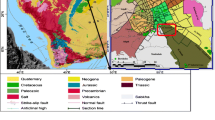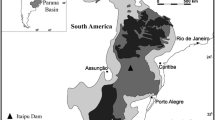Abstract
Karstification is a phenomenon that is more common in limestone and gypsum than in other rocks. Despite their equal geological conditions such as tectonics and hydrology, karstification in limestone and gypsum is different in the Ramhormoz area in Zagros folded zone in the southwest of Iran. This study aims to evaluate the lithological, physical, and mechanical properties of gypsum and limestone from Gachsaran and Asmari formations in the Ramhormoz area as well as their relationship with karstification features. This investigation involves two main parts: a morphological study and laboratory tests. First, morphological features of karsts were measured in gypsum and limestone. Then lithological, physical, and mechanical properties of the two were measured using laboratory tests such as SEM and XRD analyses, a calcimeter test, dry density, saturated density, porosity, solubility, durability, Uniaxial Compressive Strength (UCS), and the Brazilian tensile tests. In the next step, the relationship between laboratory properties and karstification phenomena in these types of rocks was obtained. In this study, limestones were divided into four types based on calcite content, and gypsums were divided into two types based on texture: alabaster gypsum and porphyritic gypsum. Karst morphology studies show a higher frequency and larger dimensions of caves and karrens in limestone types 1 and 2, and collapse and cap rock sinkholes in porphyritic gypsum. The results of laboratory tests show that, compared to gypsum, limestone has higher compressive strength and slake durability and low dissolution potential. Because of their high strength and durability, karst features such as cave and karren are more stable in limestone compared to gypsum which has low strength and durability and high dissolution and is also unstable. According to this research, the karst in limestone is stable while in gypsum it is unstable.












Similar content being viewed by others
References
Adamo N, Sissakian V, Al-Ansari N, Knutsson S, Laue J, Elagely M (2018) Comparative study of Mosul and Haditha Dams, Iraq: foundation treatments in the two dams. Earth Sci. Geotech Eng 8:53–70
Ahmed K, Masoud A (2017) Impacts of karst phenomena on engineering properties of limestone foundation bed, Ar Riyadh, Saudi Arabia. Arab J Geosci 10:347–364
ASTM (1996) Annual book of ASTM standards, soil and rock. ASTM, Philadelphia
Azizi Y, Menani M, Hemila M, Boumezbeur A (2014) Karst sinkholes stability assessment in Cheria Area, NE Algeria. Geotech Geol Eng 32:363–374
Barmaki M, Rezaei M, Raeisi E, Ashjari J (2019) Comparison of surface and interior karst development in Zagros karst aquifers, southwest Iran. J Cave Karst Stud 81(2):84–97
Berberian M (1995) Master ‘“Blind”’ thrust faults hidden under the Zagros folds: active basement tectonics and surface morphotectonics. Tectonophysics 241:193–224
Boroujeni B, Ashjari J, Karimi H (2019) Geological and hydrological effective factors in the high permeability zone of several dam sites of the Zagros region. Iran J Cave Karst Stud 81(1):9–24
Bosak P, Bruthans J, Filippi M, Svoboda T, Smid J (1999) Karst and caves in salt diapers Se Zagros MTS (Iran). J Acta Carsol 28:41–75
Brown E (1981) Rock characterization, testing and monitoring (ISRM suggested methods). Pergamon, London
Calligaris C, Ghezzi L, Petrini R, Lenza D, Zini L (2019) Evaporite dissolution rate through an on-site experiment into piezometric tubes applied to the real case-study of Quinis (NE Italy). Geoscience 9(7):298–321
Deere D, Miller R (1966) Engineering classification and index properties for intact rock. Technical report no. AFWL-TR-65-116, NewMexico
Dickson JAD (1966) Carbonate identification and genesis as revealed by staining. J Sediment Petrol 36(2):491–505
Ford DC, Williams PW (1989) Karst geomorphology and hydrology. Unwin Hyman, pp 601
Ghabezloo S, Pouya A (2006) Numerical modelling of the effect of weathering on the progressive failure of underground limestone mines. International Symposium of the International Society for Rock Mechanics, Eurock
Ghobadi MH (1997) The influence of aperture of joints on solubility of carbonaceous rocks. In Proceedings international symposium on engineering geology and the environment, pp 127–131
Gutierrez F, Guerrero J, Lucha P (2008) A genetic classification of sinkholes illustrated from evaporate paleokarst exposures in Spain. Environ Geol 53:993–1006
James GA, Wynd JG (1965) Stratigraphic nomenclature of the Iranian oil Consortium agreement area. AAPG Bull 49:2182–2245
Klimchouk AB, Aksem SD (2005) Hydrochemistry and solution rates in gypsumkarst: case study from the western Ukraine. Environ Geol 48:307–319
Lashkaripour GR, Rastegarnia A, Ghafoori M (2018) Assessment of brittleness and empirical correlations between physical and mechanical parameters of the Asmari limestone in Khersan 2 dam site, in southwest of Iran. J Afr Earth Sci 138:124–132
Mahboubi A, Jafari J, Moussavi-Harami R, Al-Aasm IS (2020) The effects of diagenesis on the petrophysical and geochemical attributes of the Asmari Formation, Marun oil field, southwest Iran. Pet Sci 17:292–316
Milanovich PT (1981) Karst hydrogeology. Water Resources Publications, Colorado
Mohammadian M, Lashkaripour GR, Ghafoori M, Hafezi Moghaddas N (2019) Environmental Impacts of Gachsaran Formation in Maydavood Plain, East of Khuzestan province. Environ Sci J 17(1):57–72 (In Persian with English abstract)
Moradi S, Kalantari N, Charchi A (2016) Karstification potential mapping in northeast of Khuzestan province, Iran, using Fuzzy Logic and Analytical Hierarchy Process (AHP) techniques. Geopersia 6(2):265–282
Parise M, Lollino P (2011) A preliminary analysis of failure mechanisms in karst and man-made underground caves in Southern Italy. Geomorphology 134:132–143
Parise M, Triscuzzi MA (2007) Geomechanical characterization of carbonate rock masses in underground karst systems: a case study from Castellana-Grotte (Italy). Karst Cryokarst Univ Silesia 45:227–236
Stocklin J (1968) Structural history and tectonics of Iran: a review. AAPG Bull 52:1229–1258
Tony W, Fred B, Martin C (2005) Sinkholes and subsidence. Springer Publication, Berlin
Torabi-Kaveh M, Heidari M, Miri M (2012) Karstic features in gypsum of Gachsaran Formation (case study; Chamshir Dam reservoir, Iran). Carbonates Evaporites 27:291–297
Waele J, Plan L, Audra Ph (2009) Recent developments in surface and subsurfacekarst geomorphology: an introduction. Geomorphology 106:1–8
Waltham A, Fookes P (2003) Engineering classification of karst ground condition. Eng Geol Hydrogeol 36:101–118
Williams D, Namara K (1992) Limestone to dolomite to dedolomite conversion and its effect on rock strength: a case study. Quart J Eng Geol Hydrogeol 25:131–135
Yilmaz I, Karakan E (2005) Slaking durability and its effect on the doline formation in the gypsum. Environ Geol 47:1010–1016
Yossef H, Ilia W, Dagan B (2010) Stability of shallow karstic caverns in blocky rock masses. Int J Rock Mech Min Sci 47:1289–1303
Acknowledgements
The authors are grateful to Mr. Salar Asadi and Miss. Leila Asadi for the valuable help in the field. We also would like to thank the Ferdowsi University of Mashhad for the financial support.
Author information
Authors and Affiliations
Corresponding author
Additional information
Publisher's Note
Springer Nature remains neutral with regard to jurisdictional claims in published maps and institutional affiliations.
Rights and permissions
About this article
Cite this article
Mohammadian, M., Lashkaripour, G.R., Moghaddas, N.H. et al. An investigation on karst development in gypsum and limestone (case study; Zagros folded zone, southwest of Iran). Carbonates Evaporites 36, 45 (2021). https://doi.org/10.1007/s13146-021-00702-z
Accepted:
Published:
DOI: https://doi.org/10.1007/s13146-021-00702-z




